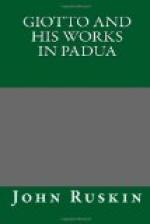[Footnote 22: The exact date, 1290, is given in the title-page of the volume.]
I have given this woodcut for another reason also: to explain more clearly the mode in which Giotto deduced the strange form which he has given to the stream of the Jordan. In the earlier Northern works it is merely a green wave, rising to the Saviour’s waist, as seen in the woodcut. Giotto, for the sake of getting standing-ground for his figures, gives shores to this wave, retaining its swelling form in the centre,—a very painful and unsuccessful attempt at reconciling typical drawing with laws of perspective. Or perhaps it is less to be regarded as an effort at progress, than as an awkward combination of the Eastern and Western types of the Jordan. In the difference between these types there is matter of some interest. Lord Lindsay, who merely characterises this work of Giotto’s as “the Byzantine composition,” thus describes the usual Byzantine manner of representing the Baptism:
“The Saviour stands immersed to the middle in Jordan (flowing between two deep and rocky banks), on one of which stands St. John, pouring the water on His head, and on the other two angels hold His robes. The Holy Spirit descends upon Him as a dove, in a stream of light, from God the Father, usually represented by a hand from Heaven. Two of John’s disciples stand behind him as spectators. Frequently the river-god of Jordan reclines with his oars in the corner.... In the Baptistery at Ravenna, the rope is supported, not by an angel, but by the river-deity Jordann (Iordanes?), who holds in his left hand a reed as his sceptre.”
Now in this mode of representing rivers there is something more than the mere Pagan tradition lingering through the wrecks of the Eastern Empire. A river, in the East and South, is necessarily recognised more distinctly as a beneficent power than in the West and North. The narrowest and feeblest stream is felt to have an influence on the life of mankind; and is counted among the possessions, or honoured among the deities, of the people who dwell beside it. Hence the importance given, in the Byzantine compositions, to the name and specialty of the Jordan stream. In the North such peculiar definiteness and importance can never be attached to the name of any single fountain. Water, in its various forms of streamlet, rain, or river, is felt as an universal gift of heaven, not as an inheritance of a particular spot of earth. Hence, with the Gothic artists generally, the personality of the Jordan is lost in the green and nameless wave; and the simple rite of the Baptism is dwelt upon, without endeavouring, as Giotto has done, to draw the attention to the rocky shores of Bethabara and AEnon, or to the fact that “there was much water there.”




